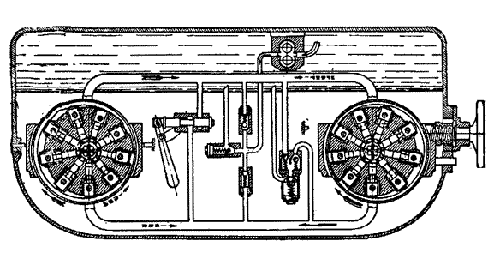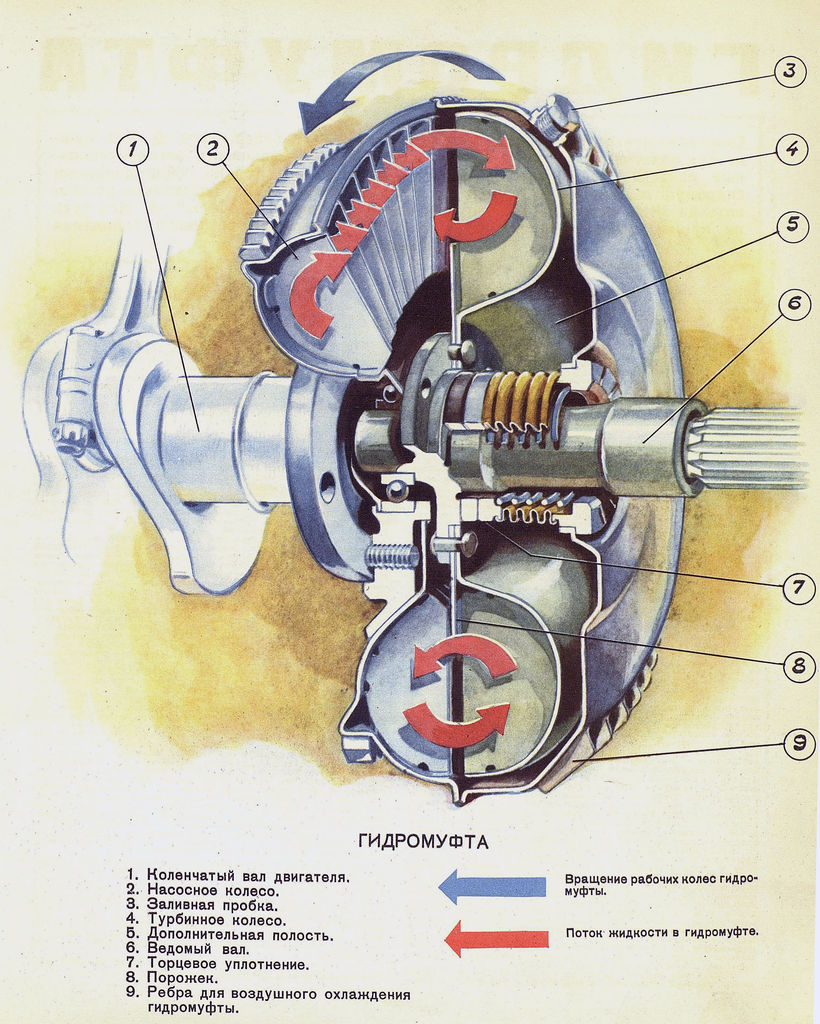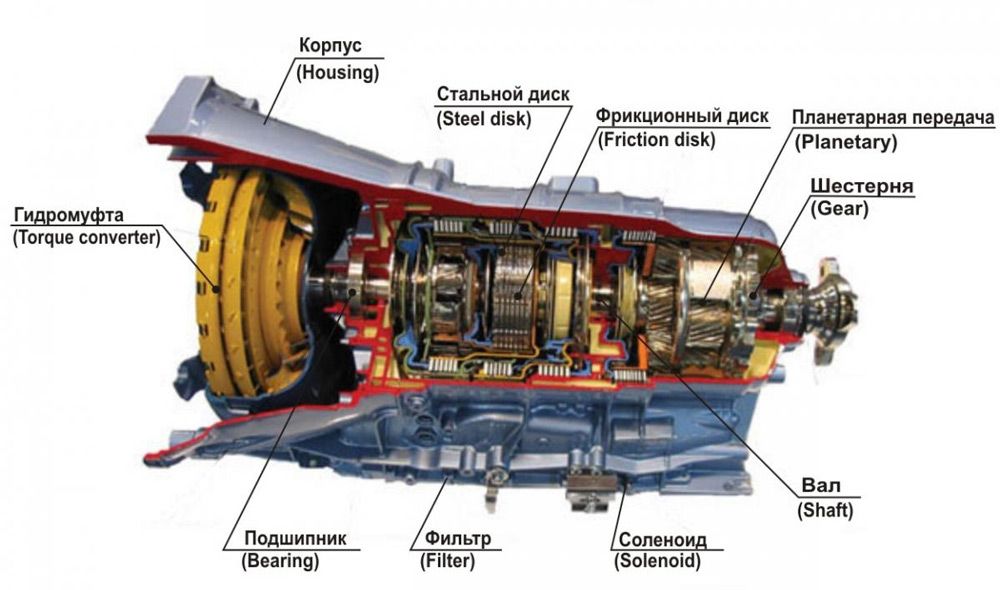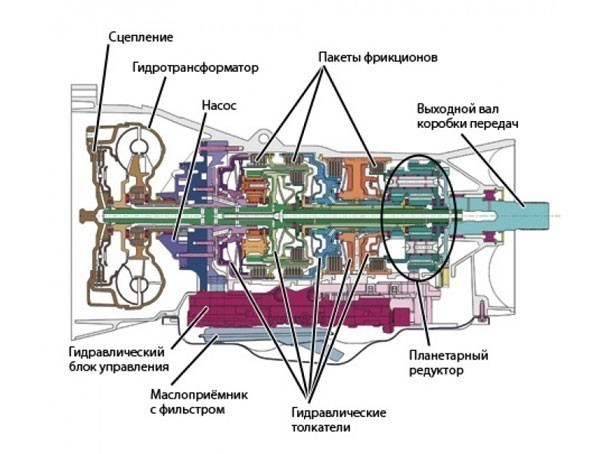An automatic transmission is a device that allows you to independently, that is, without the direct participation of the driver, select one or another gear for movement. We will try to tell everything about automatic transmission, starting from the history of development, ending with how to use automatic transmission correctly.
How did the automatic transmission
The modern automatic transmission appeared thanks to three directions in mechanics, which were developed independently of each other and subsequently became a single unit that allows you to shift gears automatically, depending on the speed of the car.
The first development in this direction was the appearance of a planetary gear, which became the main mechanism Ford T cars even at the beginning of the 20th century. The essence of the operation of this device was to ensure that the gears turn on smoothly with the help of two pedals. One of them worked for upshifts and downshifts, and the other activated the reverse gear. In those days, this was really a novelty, because then synchronizers were not yet used in car transmissions to ensure smooth switching.

The second direction was the appearance in the 30s of the last century of the first semi-automatic gearbox, when the hydraulic clutch began to control the planetary mechanism. At the same time, the use of the clutch in the car was not canceled. This invention belongs to the well-known company General Motors.
Well, the latest invention was fluid coupling application in this type of transmission, which minimized the appearance of jerks. In addition, this time, in addition to 2 steps, an overdrive was introduced for the first time - an overdrive, while the gear ratio did not exceed one.
Chrysler, which introduced this innovation in the 1930s, introduced a new type of transmission, the semi-automatic, although it is now considered mechanical.

Ultimately, the automatic transmission, in the form that it is used to seeing, appeared in the 1940s and was created by General Motors. In the same period, the company abandoned the use of a fluid coupling and began to use a special torque converter, which excluded the possibility of slipping of the element. Later, a standard was introduced that implied five selector positions on automatic transmissions: "D", "L", "N", "R" and "P".
The device and principle of operation of the automatic transmission

The design of the automatic box includes the following elements:
- torque converter- plays the role of a clutch and ensures the smooth running of the mechanism. The main function of the torque converter is considered to be the smooth transmission of torque from the flywheel to the automatic transmission shaft.
- Planetary gearboxes- sequential transmission of torque.
- Friction type clutches. In another way, they are called "packages". Provide gear change. Provide communication between gear mechanisms and break it.
- Freewheel. It plays the role of a synchronizer and reduces the load that occurs when the "packets" come into contact. In addition, in some designs, automatic transmissions exclude the possibility of engine braking, leaving overdrive in operation.
- Shafts and drums to connect all parts of the box.
Regardless of the design of the automatic transmission, they shift gears according to the same principle. All switching is carried out by moving the oil inside the automatic transmission, by turning on certain spools. Control of spools can be of two types: electric or hydraulic.

The hydraulic drive uses oil pressure generated by a centrifugal governor that is connected to the gearbox shaft. In addition, pressure is created at the moment when the driver presses the gas pedal. Thus, the automation receives information about the position of the accelerator and performs the necessary switching of the spools.
The electric drive uses solenoids that are installed in spools and connected to the automatic transmission control unit. In most cases, this block has a close relationship with . It turns out that gear shifting will be carried out depending on the throttle position, gas pedal, vehicle speed and many other parameters.
How to use an automatic transmission correctly + Video
Without a doubt, an automatic transmission provides driving comfort, although many drivers still prefer a manual transmission, feeling the car and completely controlling the transmission. Despite this, there is still a large percentage of those who really fell in love with automatic transmission.
If you are just planning to master a new type of transmission, then you need to take into account a few nuances that will save you from premature failure of the assembly, because planetary gears are very sensitive to mechanical overloads.
In total there are several positions of the selector:
- "N" - neutral gear A. Needs no comment, it's the same as a normal mechanical box.
- "P" - "parking". This position allows you to block the drive wheels and exclude the possibility of rolling the car when parking.
- « D "- used to move the car forward. In fact, it is the main position of the selector, which is responsible for all automatic switching.
- "L" - downshift. It is an analogue of the first gear of a manual transmission. Designed to overcome sections of the road where driving at high speed is unacceptable.
- « R" - reverse gear. Used to move the car backwards.

Having dealt with the provisions of the selector, it's time to learn how to use it correctly. First of all, starting the engine is permissible in the "P" or "N" positions and with the brake pedal fully depressed. To switch to the “D” position, without releasing the brake, take your foot off the gas and press the selector lock button, move it and start moving.
At the same time, it should be borne in mind that with any change in the position of the selector, in no case should you press the gas pedal.
A few important points:
For an automatic transmission, the "swing" method when overcoming a snow barrier is unacceptable. This is due to the fact that it is necessary to completely stop the car when moving the selector from position "D" to "R". Otherwise, you can simply render the entire transmission mechanism unusable.
- You can only move in winter good winter tires with a sufficiently large tread pattern. In this case, you need to set the selector to position "W" or "1", "2", "3". This is due to the fact that when the wheels hit the ice, the automation “thinks” that the car is not loaded and accelerates, which naturally leads to a gear change. Thus, a sharp skid of the car is obtained.
- and is recommended only on a tow truck or by partial loading of the drive wheels. The fact is that the gearbox oil pump is driven by the internal combustion engine, and when it is turned off, the oil supply is turned off, which accordingly leads to wear of the gearbox mechanisms. However, the developer took this factor into account, leaving a few towing rules. For example, the fact that the speed should not exceed 40 km / h (although exceptions are possible), the box should not be filled with oil as usual, but up to the very neck and the maximum towing distance should not exceed 30 km. At the same time, it is necessary to stop and give time to the mechanism to cool down, since at these moments it overheats very much. Many models with automatic transmission cannot be towed at all, for example, all-wheel drive. Although you can disconnect the cardan and immerse the front wheels.
- Automatic transmission not for extreme driving and in no case will tolerate such tricks as pressing the gas and brake pedals at the same time. All this will lead to overheating and subsequent failure of the unit.
That's all you need to know about automatic transmission.







